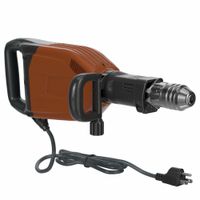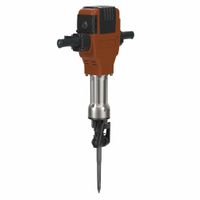Call +(254) 703 030 000 / 751 483 999 / 721 704 777
- Home
- Tools
- Power Tools
- Rotary Hammers Demolition Hammers Breaker Hammers
- Demolition Hammers Breaker Hammers
.....Read More
Frequently Asked Questions
What is the difference between a demolition hammer and a breaker hammer?
A demolition hammer and a breaker hammer are both powerful tools used for breaking and demolishing hard materials like concrete, asphalt, and masonry, but they have distinct differences in design, application, and functionality.
1. **Design and Size**:
- **Demolition Hammer**: Typically smaller and more compact, designed for handheld use. It is ideal for vertical or overhead work due to its manageable size and weight.
- **Breaker Hammer**: Generally larger and heavier, often requiring a stand or cart for support. It is designed for horizontal or ground-level work, providing more power for breaking through thicker materials.
2. **Power and Impact**:
- **Demolition Hammer**: Offers high impact energy but is usually less powerful than a breaker hammer. It is suitable for medium-duty tasks and precision work where control is essential.
- **Breaker Hammer**: Delivers greater impact energy, making it suitable for heavy-duty tasks. It is used for breaking large, thick slabs of concrete or asphalt.
3. **Applications**:
- **Demolition Hammer**: Best for tasks like removing tiles, breaking small sections of concrete, or chiseling. It is often used in renovation projects where precision is required.
- **Breaker Hammer**: Ideal for large-scale demolition projects, such as breaking up roads, pavements, or large concrete structures.
4. **Operation**:
- **Demolition Hammer**: Operated manually, allowing for more precise control over the tool's movement and impact.
- **Breaker Hammer**: Often requires less manual handling due to its weight and is sometimes mounted on machinery for large-scale operations.
In summary, the choice between a demolition hammer and a breaker hammer depends on the scale and nature of the demolition task, with demolition hammers being more suitable for smaller, precise jobs and breaker hammers for larger, more demanding projects.
How do I choose the right demolition or breaker hammer for my project?
1. **Project Scope**: Determine the size and type of the project. For light demolition tasks like tile removal, a lighter hammer (10-20 lbs) is sufficient. For heavy-duty tasks like breaking concrete slabs, opt for a heavier model (30-60 lbs).
2. **Material Type**: Identify the material you will be working with. Softer materials like plaster require less power, while harder materials like reinforced concrete need more powerful hammers.
3. **Power Source**: Choose between electric, pneumatic, or hydraulic hammers. Electric hammers are versatile and easy to use, pneumatic hammers are powerful but require an air compressor, and hydraulic hammers are best for heavy-duty tasks.
4. **Impact Energy**: Look for the impact energy rating, measured in joules or foot-pounds. Higher impact energy means more power to break through tough materials.
5. **Weight and Maneuverability**: Consider the weight of the hammer. Heavier hammers provide more power but can be difficult to handle for extended periods. Ensure the tool is comfortable to use and maneuver.
6. **Vibration Control**: Opt for models with vibration control features to reduce user fatigue and increase comfort during prolonged use.
7. **Bit Compatibility**: Ensure the hammer is compatible with various bits and chisels for versatility in different tasks.
8. **Durability and Maintenance**: Choose a model known for durability and ease of maintenance. Check for features like dust protection to extend the tool's lifespan.
9. **Budget**: Set a budget and compare models within that range. Consider long-term value over initial cost.
10. **Brand and Reviews**: Research reputable brands and read user reviews to gauge reliability and performance.
11. **Safety Features**: Look for features like automatic shut-off and overload protection for enhanced safety.
What safety precautions should I take when using a demolition or breaker hammer?
1. **Personal Protective Equipment (PPE):** Wear safety goggles, ear protection, hard hats, gloves, and steel-toed boots to protect against flying debris, noise, and potential foot injuries.
2. **Inspect Equipment:** Before use, check the hammer for any damage or wear. Ensure all parts are secure and functioning properly.
3. **Read the Manual:** Familiarize yourself with the manufacturer's instructions and safety guidelines specific to the model you are using.
4. **Secure Work Area:** Clear the area of unnecessary personnel and obstacles. Use barriers or warning signs to keep bystanders at a safe distance.
5. **Proper Handling:** Use both hands to operate the hammer, maintaining a firm grip. Stand with a stable posture to prevent loss of balance.
6. **Electrical Safety:** If using an electric model, ensure the power source is grounded. Avoid using in wet conditions to prevent electric shock.
7. **Ventilation:** Ensure adequate ventilation when working indoors to avoid inhaling dust and fumes. Use dust extraction systems if available.
8. **Correct Bit Selection:** Use the appropriate bit for the material being demolished to ensure efficiency and safety.
9. **Avoid Overreach:** Do not stretch or lean excessively while operating the hammer. Keep the tool close to your body.
10. **Regular Breaks:** Take frequent breaks to prevent fatigue, which can lead to accidents.
11. **Emergency Procedures:** Be aware of emergency shut-off procedures and have a first aid kit readily available.
12. **Training:** Ensure that all operators are properly trained in the use of the equipment.
13. **Maintenance:** Regularly maintain and service the hammer to ensure it remains in safe working condition.
14. **Environmental Awareness:** Be aware of the surroundings, including potential hazards like gas lines or electrical wires.
Are corded or cordless demolition hammers better for heavy-duty tasks?
Corded demolition hammers are generally better suited for heavy-duty tasks compared to cordless models. They offer consistent power output, which is crucial for demanding applications like breaking concrete or masonry. Corded models are not limited by battery life, allowing for uninterrupted work sessions, which is essential for large-scale projects. They also tend to have higher power ratings, providing more impact energy and efficiency in breaking through tough materials.
Cordless demolition hammers, while offering greater mobility and convenience, often have limitations in terms of power and battery life. They are ideal for tasks where portability is a priority or where access to power outlets is limited. However, for continuous heavy-duty work, the need to recharge or swap batteries can lead to downtime, reducing overall productivity.
In summary, for heavy-duty tasks requiring sustained power and efficiency, corded demolition hammers are typically the better choice.
How do I maintain and care for my demolition or breaker hammer?
To maintain and care for your demolition or breaker hammer, follow these steps:
1. **Regular Inspection**: Before and after each use, inspect the tool for any visible damage or wear, especially on the power cord, plug, and housing.
2. **Cleanliness**: Keep the tool clean by wiping it down with a damp cloth. Remove dust and debris from vents and moving parts to prevent overheating and ensure efficient operation.
3. **Lubrication**: Regularly lubricate the tool according to the manufacturer's instructions. This typically involves applying grease to the tool's moving parts, such as the piston and chuck, to reduce friction and wear.
4. **Check Fasteners**: Ensure all screws, bolts, and nuts are tight. Loose fasteners can lead to malfunction or damage.
5. **Bit Maintenance**: Inspect and maintain the bits. Sharpen or replace them as needed to ensure effective performance. Dull bits can strain the motor and reduce efficiency.
6. **Storage**: Store the tool in a dry, clean place. Use the original case if available to protect it from dust and moisture.
7. **Electrical Safety**: Regularly check the power cord for cuts or frays. Replace damaged cords immediately to prevent electrical hazards.
8. **Cooling**: Allow the tool to cool down after extended use to prevent overheating. Avoid using it continuously for long periods without breaks.
9. **Follow Manufacturer’s Guidelines**: Adhere to the maintenance schedule and guidelines provided in the user manual. This includes specific instructions for your model.
10. **Professional Servicing**: Periodically have the tool serviced by a professional to ensure all components are functioning correctly and to address any potential issues.
By following these steps, you can extend the life of your demolition or breaker hammer and ensure it operates safely and efficiently.
What are the best brands for demolition and breaker hammers?
Some of the best brands for demolition and breaker hammers include:
1. **Hilti**: Known for high-quality, durable tools, Hilti offers powerful demolition hammers with advanced features like active vibration reduction and dust removal systems.
2. **Bosch**: Bosch provides a range of demolition hammers known for their reliability and performance. Their tools often feature vibration control and ergonomic designs for user comfort.
3. **Makita**: Makita is renowned for producing robust and efficient demolition hammers. They offer models with anti-vibration technology and efficient motor systems for prolonged use.
4. **DeWalt**: DeWalt's demolition hammers are known for their durability and power. They often include features like shock absorption and variable speed controls for precision work.
5. **Milwaukee**: Milwaukee offers heavy-duty demolition hammers with advanced technology for enhanced performance. Their tools are designed for professional use, with features like anti-vibration systems.
6. **Hitachi/Metabo HPT**: Known for innovation and quality, Hitachi (now Metabo HPT) provides demolition hammers that are powerful and efficient, with features like user-friendly designs and vibration reduction.
7. **Kango**: Kango specializes in demolition tools, offering hammers that are robust and designed for heavy-duty applications, with features that enhance user comfort and tool longevity.
8. **Wacker Neuson**: This brand is known for its industrial-grade demolition hammers, offering high impact energy and durability for demanding construction environments.
These brands are recognized for their commitment to quality, innovation, and user safety, making them top choices for professionals in construction and demolition work.
Can demolition hammers be used for tasks other than breaking concrete?
Yes, demolition hammers can be used for tasks other than breaking concrete. These versatile tools are designed for heavy-duty applications and can handle a variety of materials and tasks. Here are some alternative uses:
1. **Tile Removal**: Demolition hammers can efficiently remove tiles from floors and walls. The tool's power and chisel attachments make it easier to break the adhesive bond and lift tiles without excessive manual effort.
2. **Brick and Masonry Work**: They can be used to break down brick walls or structures, making them useful for renovation projects where partial demolition is required.
3. **Asphalt Breaking**: Demolition hammers can break up asphalt surfaces, such as driveways or roads, for repair or replacement.
4. **Frozen Ground**: In colder climates, they can be used to break through frozen ground, making it easier to dig or perform other ground-related tasks.
5. **Metal Cutting**: With the appropriate attachment, demolition hammers can cut through metal, such as rebar or metal rods, which is often necessary in construction and demolition projects.
6. **Wood and Timber**: They can be used to break apart wooden structures or large timber pieces, especially in demolition or remodeling projects.
7. **Compact Soil**: Demolition hammers can be used to compact soil in small areas, although this is not their primary function.
8. **Removing Stubborn Objects**: They can help remove stubborn objects embedded in concrete or other hard surfaces, such as old bolts or anchors.
While demolition hammers are primarily designed for breaking concrete, their power and versatility make them suitable for a range of other tasks, provided the correct attachments and safety precautions are used.

